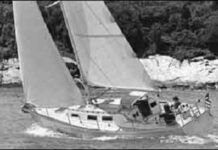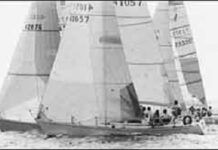Hinckley Bermuda 40
The Bermuda 40 is a centerboarder, and this is a major reason for its continuing appeal. If shoal draft is a requirement, as it often is in some areas of the U.S., one is forced to consider a centerboard design or, when available, a wing keel.
Irwin Citation 38
As the largest of the Citations, the Irwin Citation 38 is probably the best looking, handling the high-sidedness better than her smaller sisters. The boat has three windows set in the sheer stripe on each side, so they are not very noticeable. Like the other Citations it is distinctly modern-looking not pretty, but not ugly either.
J/34c
In appearance, the J/34c looks much like her sister J/cruisers. She has a fixed shoal draft keel, a straight sheer, and a slotted Goiot aluminum toerail. Her waterline, at 30', is long. It leaves her little overhang for appearance.
J/35
In design, the 35 looks like a typical Rod Johnstone boat, with short overhangs for a long waterline, relatively low and flat sheerline, a low cabin house, and a moderate well-balanced rig. Obviously, Johnstone knows something about the harmony between a boat's underbody and the water, but a large part of the boat's speed is also dependent on the light weight--10,500 pounds on a 30-foot waterline--as well as a good distribution of that weight.
Luders 33
The Luders 33 was designed by Bill Luders and built by Allied Yachts of Catskill, NY, from 1966 to 1974. The builder of the Luders 33, Allied Yachts, had a troubled existence, struggling for survival from the early 1970s until the firm finally succumbed for good in 1981. Throughout its nine year production run, a bit more than 100 Luders 33s were built. Still, like such similar boats as the Alberg 30, the relative scarcity and traditional styling have made it a bit of a cult object.
Morgan 34
By today's standards, the Morgan 34 is a small boat, comparable in accommodations to a lot of 30-footers. When the boat was designed, she was as big as most other boats of her overall length. In profile, the boat has a sweeping, moderately concave sheer. The ends of the boat are beautifully balanced: the bow profile is a slight convex curve, the overhanging counter aft is slightly concave. Esthetically, hull shapes of this period from the best designers are still hard to beat.
Morgan 38/382
In 1977, the Morgan 382 was introduced, designed by Ted Brewer, Jack Corey and the Morgan Design Team. According to Brewer, the boat was loosely based on the Nelson/Marek-designed Morgan 36 IOR One Ton. The most obvious difference between the 38 and 382 was the elimination of the centerboard and the addition of a cruising fin keel (NACA 64 012 foil) with skeg-mounted rudder. They are two completely different designs from two different eras in yacht design.
Niagara 31/35
Best known for his big race boats, Argentinean designer German Frers drew the lines of the Niagara 31. The 35, as noted, was drawn by Mark Ellis, who also designed the Nonsuch line, and more recently, the Northeast 37 motorsailer. The 35 came first, in 1978, and about 300 were built before its run came to an end in 1995. The Niagara 31 was built between 1980 and 1984. A less popular 26-footer also was built, as well as a 42.
Nicholson 35
Just over 200 Nicholson 35s were built over more than a 10-year period, with production tailing off in the early 1980s. Most boats were sold in England, but a number were built for American owners, and still more found their way to the U.S. during the rampage of the dollar against foreign currencies in the mid 1980s. The Nicholson 35 is a cruising boat, plain and simple. Its proportions are about as common-sense and moderate as you can get. The boat is clean, almost austere in appearance, with very little exterior wood trim.
C&C 33
C&Cs have been known for good-looking moderate designs, a tradition started by the original partners and the company's chief designer Rob Ball. Some models--like the early Corvettes and C&C 35s--have become classics of production sailboats, and (except for the Mega, a one-design 30-footer of the late 70s) it's hard to think of any C&C which has been extreme or unattractive to the eye.












































